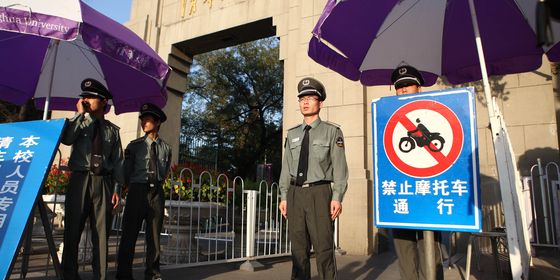The H2N2 pandemic of 1957 offers striking parallels for today
In 1957, a flu believed to have originated in China swept the world, killing over a million people, and disproportionately afflicting those over 65. Schools in the US were closed, and quarantine imposed on hard-hit areas.
Sound familiar? Though the ongoing Covid-19 pandemic has been compared to many previous outbreaks, including the H1N1 “swine flu,” SARS, and the 1918 “Spanish flu,” the outbreak with most parallels to today is arguably the 1957 pandemic, caused by the H2N2 virus. It was eventually traced back to Guizhou province, and wasn’t controlled until a vaccine was developed in late 1957.
If you haven’t heard of it, you’re not alone. Flu outbreaks are practically a dime a dozen nowadays, while pandemics still occur once every ten years or so, their severity varying each time.
But as Yale professor Dr. Nicholas Christakis, author of Blueprint: The Evolutionary Origins of a Good Society, observed, Covid-19, “resembles [the] 1957 influenza pandemic in certain epidemiological ways (despite different pathogen and different age curve), which is what makes it more alarming than other pandemics that periodically afflict us.”
The flu pandemic came at a sensitive time for China. Previous outbreaks of diseases like cholera and plague had been used by foreign powers such as Japan to legitimize their colonial incursions, by claiming that their management of disease was better than China’s. Epidemics represented not just a threat to public health, but national security.
After the establishment of the PRC in 1949, Mao Zedong made health care a priority in order to demonstrate the modernity of his “New China,” as well as its independence from outside “aid.” Some of the measures were a success, such as the introduction of “barefoot doctors,”students with a year of TCM and Western medicine training sent to provide care in the countryside. Others were not: The 1958 “Four Pests” campaign, aimed at controlling schistosomiasis by killing all rats, flies, mosquitoes, and sparrows, was a disaster.
By 1957, though, things had taken a dark turn in China’s politics. The optimism of the early 1950s had given way to the Hundred Flowers Campaign, shortly followed by the Anti-Rightist Movement. China had become essentially closed to the outside world—even its close Communist ally, the Soviet Union, had given it the cold shoulder since 1956.
While its origins are obscure, the ’57 flu was a re-assorted (mixed species) strain of avian and human flu, a genetic recombination suggesting it originated within an animal reservoir, possibly even a wet market. The outside world first learned about the danger in April, when it turned up in Hong Kong. A short report of “an influenza epidemic [that] has affected thousands of Hong Kong residents” was published on page three of The New York Times on April 17—by then, 250,000 in Hong Kong were afflicted, or about 10 percent of the population.
By mid-May, Taiwan had reported 100,00 cases. By June, India had over a million, and the flu arrived in the US via a Rhode Island military base. Soon after, it was identified in various children’s camps in California. Within five months of the first reported outbreak, it was everywhere.
There was no initial immunity to the novel strain. Like Covid-19, the 1957 flu was a ribovirus (though the two have different phyla) and, as current World Health Organization director-general Tedros Adhanom Ghebreyesus described Covid-19, a “unique virus with unique characteristics.”
Initially, outbreaks in the Northern Hemisphere were limited, but a second wave of infections, brought about by the onset of winter, occurred in November. In December the UK had reported 3,550 deaths; by March the following year, nearly 70,000 had died of the flu in the US alone.
As with today, a priority was placed on maintaining the health care system; in many cases of infection, families simply self-quarantined while neighbors left supplies. The death rates seemed to vary by age, region, GDP, and latitude (many more died in Chile than Egypt for example).
Like Covid-19, the ’57 flu disproportionally affected the old; but unlike the current pandemic, it also afflicted the very young. It showed a “baseline seasonality,” meaning infections tended to rise and fall at regular intervals. These waves tended to reflect changes in temperature, as well as social factors like when schools closed or re-opened.
Also like Covid-19, the virus spread among the working ages and the socially mobile, and was then brought into contact with those at the end of the transmission chain like medical workers, nursing home residents, and elderly relatives. This is why school closures help slow the spread of these types of virus, and self-isolation with family tends to concentrate it.
In the West, the virus was widely known as “Asian flu” (an appellation without controversy at the time), and countries debated over the proper response. In the UK, doctors argued with ministers over the correct measures to take, while the WHO gave misguided advice that the flu was “unlikely to strike until the winter.” Millions were spent on sickness benefits, and “with factories, offices and mines closed the economy was hit,” according to a news report from the time.
Ultimately, the chains of transmission was broken through “herd immunity,” when 60 percent or more of the population has recovered from the infection. This idea has also been controversially proposed for Covid-19, and ideally, requires a vaccine (rather than immunity through infection). With the 1957 flu, a larger vaccine “was required to initiate a primary antibody response than with earlier H1 vaccines” but as antibody levels increased among the population, the vaccination response improved over recurrent waves in 1958, 1959, and 1960.
Unfortunately, the world probably have at least 12 to 18 months to wait for any vaccine for Covid-19 to be ready for mass manufacture. On the other hand, its capacity for keeping track of the viral spread through surveillance, testing, and quarantine is vastly superior than 63 years ago.
The past offers lessons for combating pandemics today: for example, in 1968, a second influenza epidemic came out of Southeast Asia, known as “Hong Kong influenza” after the place where it first came to global attention. But “a decade after the 1957 pandemic, epidemiologic communication with the mainland “was even less efficient than it had been earlier,” a study found.
And there was a curious coda to the 1957 influenza—in 1977, the same flu reappeared in northern China, demonstrating new characteristics that suggested it had mutated (by mainly affecting those under 20, for example). “Genetic analysis indicated that this strain was missing decades of nucleotide sequence evolution, suggesting an accidental release of a frozen laboratory strain into the general population.” That is to say, it likely escaped from a lab where scientists were researching a vaccine for the swine flu that regularly decimated herds; no word, though, on how the ’77 version of today’s Covid rumor mill responded at the time.
Cover image of a Swedish hospital during the 1957 flu, by Scanpix / Public domain












